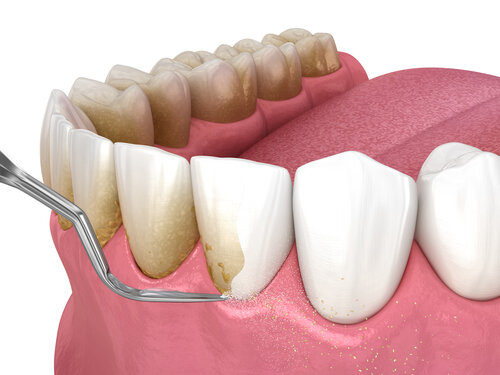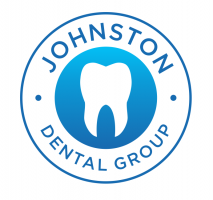Periodontal Disease Treatment
When periodontal disease (gum and bone loss) starts to take hold, often times a regular cleaning is not enough to clean the area.

Table of Contents
Periodontal disease therapy includes scaling and root planing (SRP, or deep cleaning), which allows our hygienists to remove all the bacteria below the gums. This promotes healing and gets you back on track to a healthy mouth.
Why Do I Need Periodontal Treatment?
The main goal of periodontal (or gum disease) treatment is to control infection. The number and types of treatment will vary, depending on the extent of the gum disease. Any type of treatment will require that the patient keep up good daily care at home. The doctor may also suggest changing certain behaviors, such as quitting smoking, as a way to improve treatment outcomes.
What Happens During SRP Treatment?
Deep Cleaning (Scaling and Root Planing) is the first stage of treatment to fight periodontal disease. It is a common procedure performed by our talented team of dental hygienists. In many cases, a non-injectable, topical anesthetic is administered in the pocket between the tooth and gum. The dental hygienist removes all plaque and tartar that cause the inflammatory process. Scaling means scraping off the tartar from above and below the gum line. Root planing gets rid of rough spots on the tooth root where the germs gather and can help to remove bacteria that contribute to the disease. This procedure helps gum tissue to heal and pockets to shrink, which makes it easier to keep teeth clean and control the disease. If this treatment isn’t effective in eliminating pockets or the disease is advanced, a referral to a periodontist will be given.
Is There Anything I Can Do to Cure Gum Disease?
Diligent home care and more frequent professional cleanings are crucial following scaling and root planning to stabilize and maintain this disease. Our hygienists will give you instructions and suggest dental products that can help you do your part at home. Patients with periodontal disease require cleanings every 3 months which most insurance companies recognize and allow a benefit for. This is very important to prevent periodontal disease from advancing to the point of requiring periodontal surgery.
We take this disease very seriously and screen all of our patients annually. Education is the key to prevention. Early diagnosis and treatment can help keep teeth and gums happy and healthy for many years. If caught early enough we can prevent the destruction of the bone supporting your teeth.
What to Expect After Scaling and Root Planing?
Following scaling and root planing, you can expect to notice less redness, and less bleeding, and less swelling of your gum tissue. Your gum health can be maintained with proper home care and regular professional care.
Discomfort/Pain: Many patients report minimal to no discomfort following the procedure. If there is discomfort or pain it should be acute and subside in a few days. Discomfort immediately after treatment is usually associated with slight throbbing or aching. This discomfort usually subsides in about four hours. Any discomfort due to brushing should get better in one to three days. Acetaminophen or a non-aspirin analgesic should be taken as needed to reduce discomfort. Warm salt water rinses several times a day can help soothe gums, but should not be used for more than 1 week.
Bleeding: Some slight bleeding may occur during the next several brushings but the bleeding should steadily decrease after two or three days.
Appearance: Root surfaces may be more exposed as the inflammation subsides. This may result in more spaces between teeth.
Tooth Sensitivity: Teeth may be sensitive to temperature changes and/or sweets. The use of a sensitivity control toothpaste containing potassium nitrite, and over-the-counter fluoride rinses help alleviate thermal sensitivity. In some cases, a prescription-strength fluoride toothpaste will be recommended. If sensitivity persists, professional application of fluorides can be done by your hygienist.
Oral Hygiene: Follow the home care instructions given by your hygienist. If gum tissues are tender, brush your teeth gently but thoroughly; this may take a little more time than normal. By the third to the fourth day, normal oral hygiene techniques can be resumed.
Periodontal Therapy FAQs
Periodontal therapy, or periodontal treatment, encompasses various procedures to treat gum disease and maintain oral health. Professional cleaning is usually required to remove plaque and tartar accumulation, which, if left untreated, can cause gum inflammation and eventually result in tooth loss. Depending on the severity of the condition, periodontal therapy may also include scaling and root planing to remove bacteria from below the gum line and surgical interventions such as gum grafts or flap surgery to repair damaged tissue. The ultimate goal of periodontal therapy is to restore gum health, prevent further damage, and preserve the teeth and supporting structures.
Scaling and root planing is a non-surgical periodontal treatment addressing gum disease. It involves two main steps: scaling and root planing. Scaling is the process of removing plaque and tartar buildup from the tooth surfaces, both above and below the gumline, using specialized tools. On the other hand, root planing focuses on smoothing out rough areas on the tooth roots to remove bacteria and facilitate gum reattachment.
This procedure helps to eliminate bacteria and toxins that cause inflammation, allowing the gums to heal and reducing the risk of further gum disease progression. A dental hygienist or periodontist typically performs scaling and root planing and may require multiple visits depending on the severity of the condition.
Periodontal therapy, including scaling and root planing procedures, may cause discomfort or sensitivity, but it is generally not considered painful. Local anesthesia can numb the treated area, helping minimize any discomfort during the procedure. After the treatment, some individuals may experience mild soreness or sensitivity in the gums, usually managed with over-the-counter pain relievers and proper oral hygiene practices. Overall, the benefits of periodontal therapy in addressing gum disease and maintaining oral health outweigh any temporary discomfort experienced during the process.
